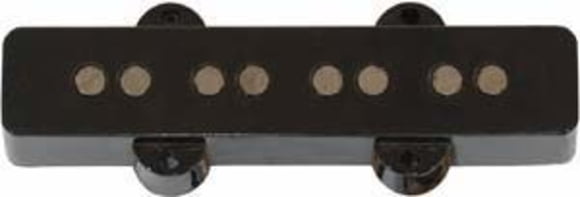3. Active or passive - that is question.
Passive pickups
Since the earliest e-basses were equipped exclusively with passive pickups, the classical rock and motown productions usually featured the sound of passive basses. Passive pickups have typically analogue sound characteristics and deliver warm, round and very dynamic sounds. The possibilities to influence the sound are generally fairly limited with passive pickups. Normally, passive e-basses have bass and treble controls (in addition to the volume control), which allow the player to decrease the treble and bass portions of the sound. Put in easy English, this means that the player can only work with what the pickups' natural frequency range offer: greater trebles and basses than the pickup provides are not available. This is by no means necessarily a defect; you simply have fewer ways of manipulating the sound than active systems offer, for example.

Since passive pickups feature stronger magnets, as a rule, than their active brothers, they also tend to catch more ambient noises. But more on that later (see the chapter on types of construction).
Active pickups
Active pickups work together with pre-amps and integrated EQs (equalizers). These are normally supplied with energy from one or two 9-volt monobloc batteries. EQs enable intensive sound manipulation, as they also allow clipping and boosting frequency ranges. It depends on each individual bass how far you can go with this. For example, 2-band EQs allow the manipulation of basses and trebles. With a 3-band EQ, you also have the option of manipulating the mids, which are extremely important for the character of the sound. And for those who want even more, basses with additional sound shaping tools (filters etc) offer almost limitless possibilities.
Further characteristics of active pickups:
In general, active pickups possess a greater output than passive pickups, and are therefore louder. Their basic sound is clear, billiant and often a little percussive, as well. Because of their weaker magnets, active pickups are less sensitive to stray noises and therefore sound very clean. But strong lights cast strong shadows: depending on the quality of the pre-amp used, it can produce unpleasant ambient noises especially when you increase the trebles significantly.
On the whole ...
...it is really difficult to give a general opinion which of the two is the better choice. Good passive pickups deliver an irresistibly warm and extremely dynamic analogue sound. Active pickups can sound clearer and subjectively cleaner, but also a little clinical at times. Thanks to the active sound controls there are also more ways of influenceing the performance. But you should keep in mind that a high-quality passive pickup sounds better than a bad active model. And vice-versa: a top-of-the-range active system may well sound warmer and more saturated than low-quality passive pickups.
In a fairly sweeping way, you may say that passive pickups deliver stellar performance with growling rock and soul bass lines as well as brute slaps. Very clean sounds, fusion leads and virtuoso slap riffs are best performed with an active bass. The more sophisticated frequency response of a 6-string bass, too, is more suited to an active system than a passive one.
And if you want the best of both worlds, simply choose a bass that can be run actively and passively!




